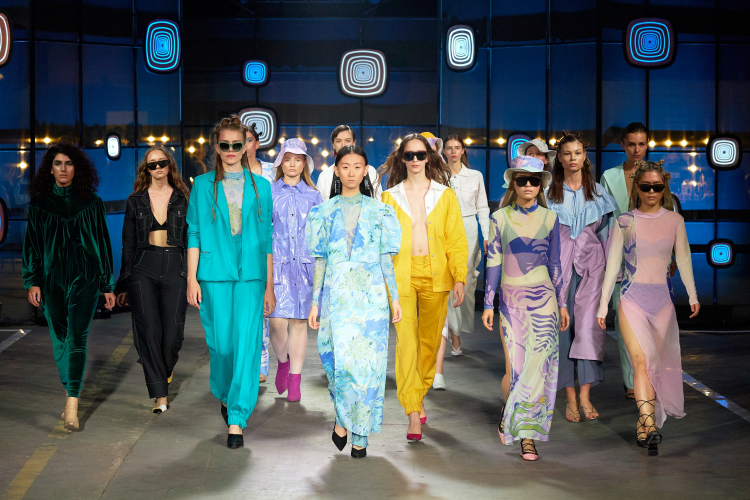The Inclusive Exclusive: Plus-Size Models on the Runway

Beauty comes in all shapes and sizes, but unfortunately, we don’t always see that on the fashion week runways. Over the past decade, the misrepresentation of body types on the runway has sparked large pushback against the luxury fashion industry. Body positivity promotes realistic beauty standards, and luxury fashion brands struggle to execute this idea. Using a “token plus-size model” lacks the true meaning of inclusivity, encouraging the opposite of its original intent.
For many decades, most traditional fashion houses filled their runways with thin, white, young models promoting extremely unrealistic body standards for their audience. Diverse models have been a focus for many designers, but they focus on models from a variety of ethnicities, not size. Many designers have made the decision to include one plus-size model to meet the demand for real women on the runway, but by doing this they make inclusivity exclusive.
The body positivity movement is about accurately representing society while celebrating positive body image and advocating for all sizes to create positive change making sure all people feel represented. This movement has always had a strong link to the fashion industry as it sets the tone of societal beauty standards. The fashion industry largely affects how people view themselves and others especially regarding body types, physical abilities, ethnicities, and genders.
The “token plus-size model” is a new marketing tactic used by many luxury fashion houses. Brands use a singular plus-size model on their runway, who are also often an ethnic minority, to illustrate the entirety of realistically sized women in society. Designers do this to acknowledge the issue, but by only including one model they misunderstand the true meaning of being body positive. In a 2021 interview with Teen Vogue, P.S. Kaguya, a plus-size Korean American model said, “People never liked me . . . I’m not skinny, not doing what a model minority should be doing.” Kaguya felt opposition towards her weight and identity, but always knew she had something to offer as she had never seen a plus-size Asian model.
photo Matty So // wearing Leak_NYC pic.twitter.com/MI6G42urxf
— Kaguya (@_pskaguya) September 6, 2022
The link between the body positivity movement and the fashion industry is greatly intertwined with social media influence. Platforms give people a voice to speak up now more than ever on things they care about, and the lack of plus-size models on the runway and their mistreatment is coming to light. A UK designer well-known for her sex-appeal red carpet designs, Nensi Dojaka, is currently under fire on social media for just this. Her London Fashion Week Spring 2023 line featured tall, skinny, unattainably-sized models and one plus-size-model, Paloma Elsesser, who coincidentally also walked the COS New York fashion show as the only plus-size model in the lineup. Paloma Elsesser is well-known in the fashion world as a “token plus-size model.” She has a huge following and is greatly supported in the industry, but her fans have noticed she is not treated as the other models. Not only is she often the only plus-size model on the runway, but she is also often put into outfits that show less skin than the other models.
@welcometotheatlas It’s NOT fair. It’s NOT nice. And it’s so transparent!! If you’re not gonna make the plus girls a look that’s matches the collection, at least tailor it to them so it looks complete. #welcometotheatlas #newyorkfashionweek #nyfw #nyfw2022 ♬ original sound - welcometotheatlas
Sara Bailey, an AUP Master's student in Global Communications and Fashion intern for a large fashion public relations consultancy, feels strongly that including one plus-size model on the runway is a step in the right direction, but that it could be done for the wrong reasons.
“There are luxury brands like Chanel who have sometimes included just one plus-size model, who isn’t even really a plus-size model, she's more like a size 6. For them it could be checking a box. But all we can hope is that it is a baby step toward doing the right thing instead of just a token.”
Sarah Bailey is making reference to Jill Kortleve, a model shown on the Chanel runway in 2020 as their first plus-size model in over a decade. However, the brand faced a lot of backlash as their audience noticed Jillian Kortleve is not even plus-sized.
This is Chanel’s “plus size” model. This is average not plus. I hate this industry sometimes pic.twitter.com/GWzrI24s5y
— Shesxolovely (@JGlxou) March 4, 2020
In 2017, The Organization for Economic Co-operation said that more than one in two adults and nearly 1 in 6 children are overweight or obese in the 38 OECD countries which include the United States, France, and more. Additionally, 1 in 10 people are obese in France, and almost 40% are overweight. The Center for Disease Control reported in 2019 that the average American woman’s measurements equate to a size 14. Yet, according to Refinery29 in 2019 plus-size women accounted for, on average, 1 to 2% of the bodies represented in mainstream media. If luxury fashion brands want to attract their audience, they need to include more plus-size models in their shows to accurately represent the people who are going to buy them. One “token plus-size model” on a runway does not even illustrate the average number of plus-size people in France or the United States.
Society is begging to feel represented on the runway, but very few brands are participating in size-inclusivity efforts. The use of one plus-sized model on the runway is not enough. Real bodies and real people who accurately represent different body sizes need to be celebrated. The fashion industry at a minimum needs to represent the average population on the runway, including enough to represent the totality of plus-size people in the world. Contrary to what you see in the media and on the runway, women come in all shapes and sizes, and they need to be represented.







